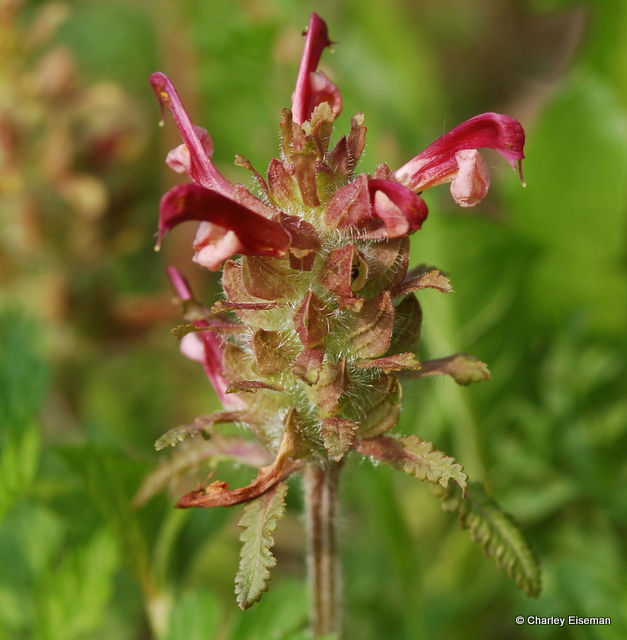2020 is off to a good start! This afternoon I gave my “Native Plants as Insect Habitat” slideshow in the Berkshires, and on the way home stopped at Noah’s house because his not-quite-six-year-old son wanted to show me the bobcat tracks they had been following all week. We got to the tracks just as it was getting too dark to see, but we followed them by flashlight for a little while, and before too long met the tracks of a yearling bear—not a common sight on January 1. So we got to trail the bear for a bit as it stopped to sniff and follow tracks of other animals, including the bobcat, a red fox, and a coyote.
Anyway, a year has gone by since I wrote my “How Many New Species?” post, so I’m re-posting it here with the 20 additional species described in 2019. Species are listed in the order in which they were described, so if you already read the previous post, you can just go to each list and skip down to the species with “2019” after the authors’ names.
—————————————————————————————————————————————–
I am often asked how many new insect species I have found (or “discovered”). I’m never quite sure how to answer this. I’ve certainly reared dozens of undescribed species of moths, for instance, that are now sitting in my office or in various museums, waiting to be named. The number for parasitoid wasps is probably even higher. But simply having “found” new species doesn’t count for much if they haven’t been properly documented and named. Also, to me the credit for “discovering” a new species mostly belongs to the taxonomist who does the hard work of comparing it with all the similar species in the world to demonstrate that it is really something new. Of all the species I have coauthored, Marmara viburnella is the only one I felt certain was undescribed (because I went to the trouble of reviewing the larval biology and adult morphology of all the previously described species in that genus) before I passed it along to a taxonomist.
With that said, for my final post of the year, I thought it would be fun to put together a list of all the species that have been either described in papers I coauthored or described based (at least in part) on specimens I collected. (This was partly inspired by my realization that I never got around to writing anything here about most of the 30 fly species I recently described with Owen Lonsdale.) With any luck, this list will continue to grow. What limits the number of new species I’m able to help describe is a shortage not of “new” species to name, but of time that my collaborators and I have available to devote to this task. So the take-home message from this post should not be “Wow, look at all the new species Charley has found!”, but rather, “Wow, we have so much left to learn about our natural surroundings, and we need to support more funding for taxonomy!”
For species I’ve written about before, you can click on the name to see the relevant post.
First, the species I did not coauthor (of these, Orchestomerus eisemani and Adelius floridensis are the only species for which one of my specimens was designated as the holotype):
1. Celticecis cornuata Gagné, 2013 – A hackberry gall midge I found in Kentucky while traveling with Noah to check out the periodical cicadas in Nashville and Sam Droege’s bees in Maryland.

2. Orchestomerus eisemani Yoshitake & Anderson, 2015 – A leafminer of Virginia creeper I found at work one day in Plymouth County, Massachusetts. This seems to be its northern range limit; although I’ve since found it in Nashville and at several sites in Ohio, I have found it just one other time in Massachusetts, at Lake Chaubunagungamaug.

3. Brachys howdeni Hespenheide (in Hespenheide & Eiseman, 2016) – I first found this trailing arbutus leafminer while hiking along the ridge just above the house where I now live. I see the mines in just about every sizable patch of the host plant I encounter.

4. Liriomyza limopsis Lonsdale, 2017 – Owen had already given this species a name based on Canadian specimens collected as adults, but no host plant was known until I reared it from white wood aster (Eurybia divaricata) and whorled aster (Oclemena acuminata) in New York and Massachusetts.

5. Liriomyza pilicornis Lonsdale, 2017 – Similar story, except that Graham Griffiths was the first to rear this species, 45 years before Julia and I found it mining leaves of bastard toadflax (Comandra umbellata) in Massachusetts.

6. Liriomyza pistilla Lonsdale, 2017 – Ditto, except in this case the host is cow-wheat (Orobanchaceae: Melampyrum lineare) and Griffiths reared it 40 years before me. I find the leaf mines pretty regularly.

7. Adelius floridensis Shimbori & Shaw, 2019 – This braconid wasp species is known only from a few specimens I reared in 2013 from the St. Johnswort leafminer Fomoria hypericella (Nepticulidae) in Florida.
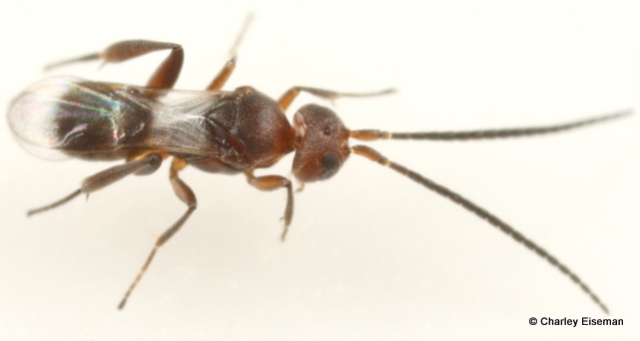
So that’s seven in the first category. I mostly just happened to give specimens to the right taxonomists at the right time: Ray Gagné was finishing up a revision of all the gall midge species on hackberries; Henry Hespenheide was (and is) in the midst of revising the genus Brachys, and Owen Lonsdale was finishing up a revision of the Canadian species of Liriomyza. In the case of Orchestomerus eisemani, Bob Anderson was inspired to revise that genus after having initially identified the weevils I had reared as O. wickhami Dietz, then discovered his error after I had published a note documenting their natural history. Adelius floridensis got to be described because Dave Wagner directed Scott Shaw and Eduardo Shimbori to me when they asked him if he had any specimens they might use in their revision of the New World braconid wasps of the tribe Adeliini. For the 62 species listed below that I have coauthored, I’m extremely grateful to the taxonomists who took time away from whatever other projects they were working on to help me put names to my natural history observations.
1. Scolioneura vaccinii Smith & Eiseman (in Smith et al. 2015) – A sawfly that mines leaves of huckleberries (Vaccinium spp.), which Julia and I found in western Washington on our first cross-country trip in search of leafminers (though we only were able to rear parasitoids, and the type specimen was reared from a larva Noah and his wife Sydne collected the following year).

2. Megaselia nantucketensis Eiseman & Hartop, 2015 – A scuttle fly that emerged from a midge gall on black oak, collected on Nantucket during the gall and leaf mine survey I’ve been conducting there since 2011.

3. Megaselia risoria Hartop, Wong & Eiseman, 2016 – The naming of this species was a byproduct of my having reared specimens of M. globipyga from a dead tussock moth caterpillar I found at work.
4. Platygaster pruni Buhl & Eiseman, 2016 – A platygastrid wasp that emerged from a midge gall on black cherry, which I collected at work one day in western Massachusetts.

5. Platygaster uvulariae Buhl & Eiseman, 2016 – A platygastrid wasp that emerged from a midge gall on wild oats (Uvularia sessilifolia)—again collected at work in western MA. No one has yet been able to rear the midge that causes this gall.
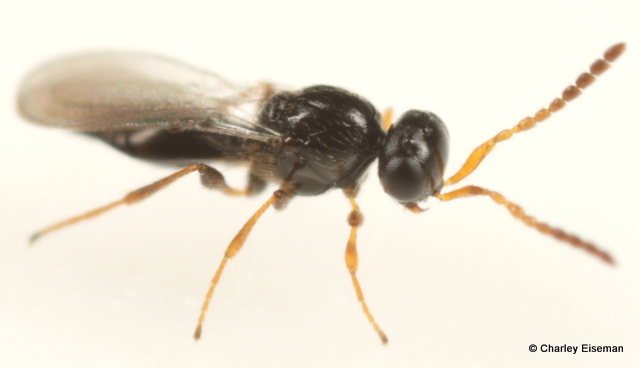
6. Platygaster vitisiellae Buhl & Eiseman, 2016 – A platygastrid wasp that emerged from a midge gall on wild grape, collected as part of the Nantucket survey. The midge species is probably undescribed (but I was able to rear some adults, which are sitting in the Smithsonian waiting for someone to decide to revise the genus Vitisiella).
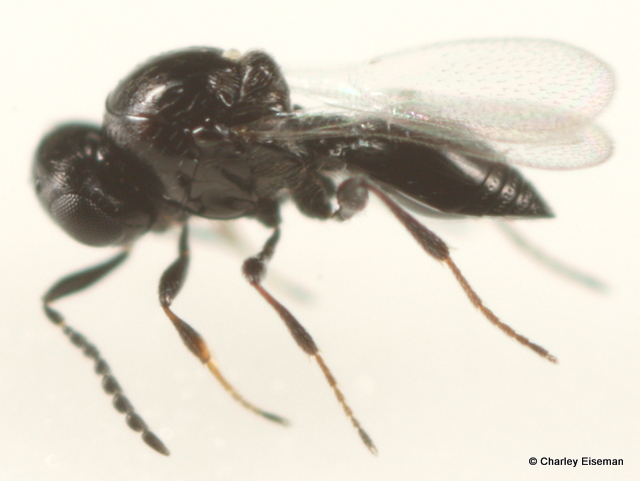
7. Zygoneura calthella Eiseman, Heller & Rulik, 2016 – A dark-winged fungus gnat that feeds in leaves and petioles of marsh marigold. Julia and I first found it while surveying for four-toed salamanders in western Massachusetts.
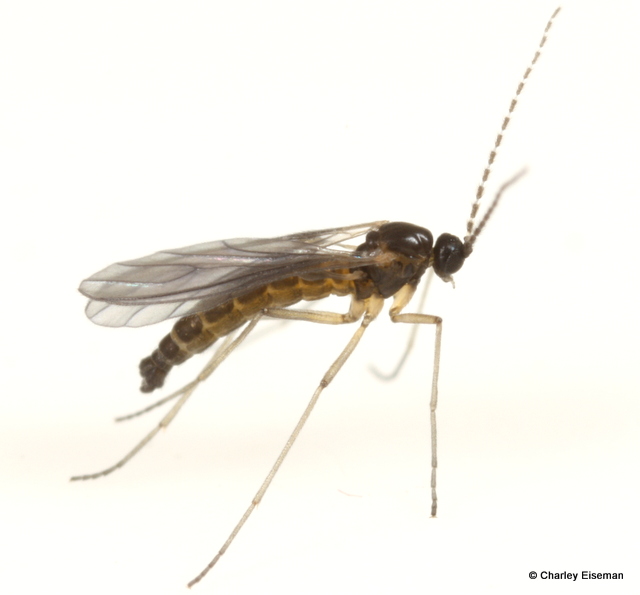
8. Fenusa julia Smith & Eiseman, 2017 – A sawfly that mines leaves of wild rose, which Julia spotted in Colorado on another leafminer-hunting road trip.

9. Marmara viburnella Eiseman & Davis (in Eiseman et al. 2017) – Another product of the Nantucket survey. The larva of this moth begins as a leafminer, then disappears down the petiole and spends most of its life feeding in the stem. Julia and I reared it from arrowwood, but mines have also been found on various other viburnums.

10. Platygaster tephrosiae Buhl & Eiseman, 2017 – Another one from Nantucket; I reared the two known specimens from midge galls that happened to be on some goat’s rue leaves that Kelly Omand collected for me to feed some leaf-tying caterpillars. I failed to rear the caterpillars, and I haven’t been able to rear the midge yet either.
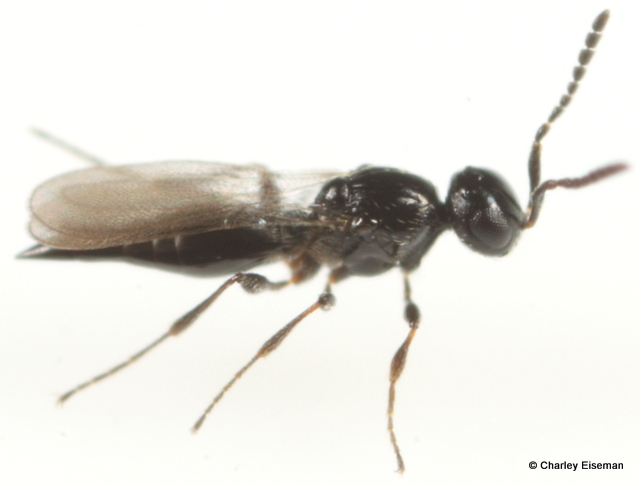
11. Platygaster vaccinii Buhl & Eiseman, 2017 – The single known specimen emerged from a gall on lowbush blueberry that I collected at the 2016 Berkshire BioBlitz on Mt. Greylock—caused by another midge that has never been reared.
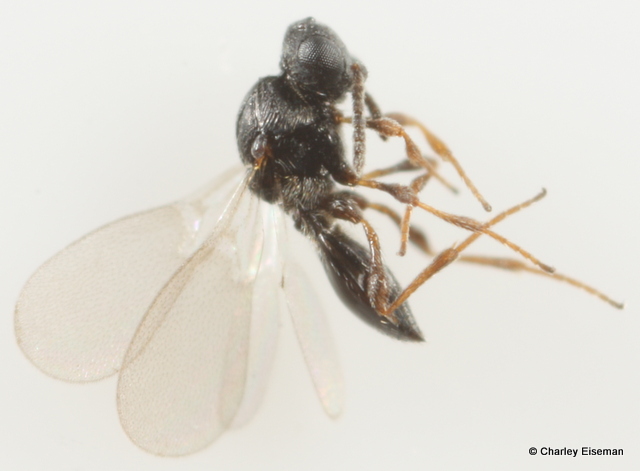
12. Macrosaccus coursetiae Eiseman & Davis, 2017 – Another one Julia and I collected on our first cross-country trip; this one from Arizona, mining leaves of a shrub called rosary babybonnets (Coursetia glandulosa).
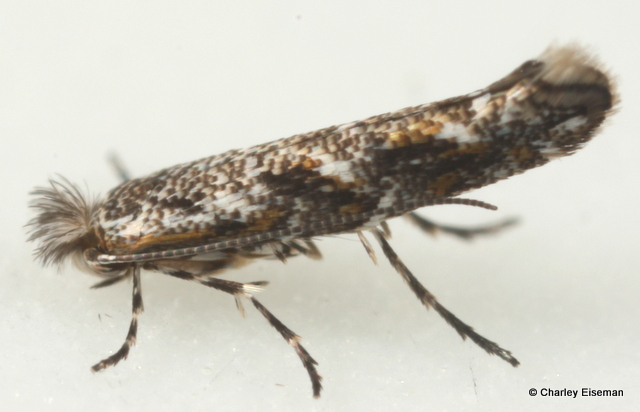
13. Phytosciara greylockensis Eiseman, Heller & Rulik, 2018 – Another one from the Mt. Greylock BioBlitz; a dark-winged fungus gnat that mines leaves of bluebead lily (Clintonia borealis).

14. Agromyza fission Eiseman & Lonsdale, 2018 – Owen had already named this species based on a specimen collected in the DC area in 1914, but the type specimen is one Julia and I collected at MJ Hatfield’s “Red Oak Prairie” in eastern Iowa on the way home from Colorado. One of the paratypes came from a larva we collected the next day on Marcie and Mike O’Connor’s land in Wisconsin, and Mike Palmer provided two from Oklahoma. The larvae mine leaves of hackberry.

15. Agromyza soka Eiseman & Lonsdale, 2018 – This is another one that Owen had already named based on a 1914 specimen from the DC area, but as with A. fission its host was unknown. It turns out to be responsible for leaf mines on black locust that since 1982 have been attributed to Phytoliriomyza robiniae (Valley), adults of which were repeatedly associated with black locust but never actually reared. Some paratypes came from specimens Julia and I reared from larvae we collected at the 2016 Connecticut BioBlitz, and the rest came from larvae Tracy Feldman found mining both black locust and wisteria in North Carolina.

16. Melanagromyza palmeri Eiseman & Lonsdale, 2018 – The only known specimen is one that Mike Palmer reared from a sunflower stem (or possibly the roots) in Oklahoma. Stem feeding members of this genus are borers rather than miners, meaning that they don’t form any externally visible trails. So rearing them takes special dedication and/or luck.
17. Ophiomyia euthamiae Eiseman & Lonsdale, 2018 – This species mines leaves of grass-leaved goldenrod (Euthamia graminifolia), mostly on the lower surface. I first noticed mines like this on Nantucket, but those were possibly made by O. maura; the whole type series of O. euthamiae came from my yard.

18. Ophiomyia mimuli Eiseman & Lonsdale, 2018 – This species mines in stems of monkeyflower. I first found it at a bioblitz on Julia’s family’s land in southern Ohio, and some paratypes came from the swampy woods right behind our house in Massachusetts.

19. Ophiomyia parda Eiseman & Lonsdale, 2018 – Another species whose holotype I collected in my yard. It is a common leafminer of asters (Symphyotrichum spp.) and seems to be responsible for all of the mines previously attributed to O. quinta.
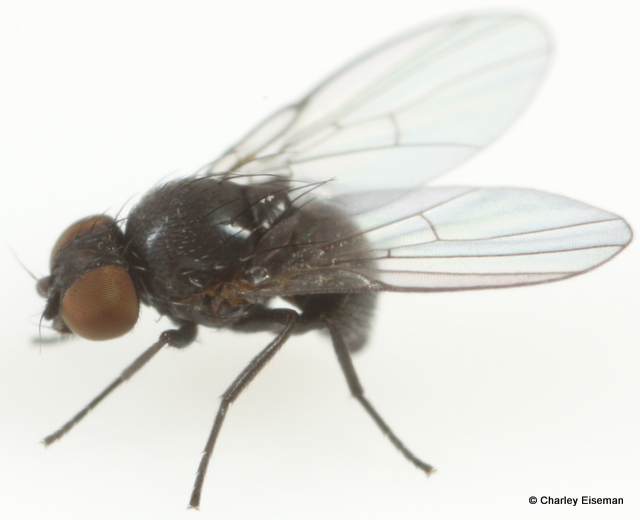
20. Calycomyza artemisivora Eiseman & Lonsdale, 2018 – This species is known only from two specimens I reared from leaf mines on Artemisia ludoviciana that Mike Palmer collected in Oklahoma.

21. Calycomyza avira Eiseman & Lonsdale, 2018 – Another one that Owen had already named before I reared it; there are several specimens at the Smithsonian from Connecticut, New York, and West Virginia, dating back to 1929. The larvae mine leaves of beggar-ticks (Bidens spp.). I reared some from mines I collected at work, and Tracy Feldman provided some from North Carolina.

22. Calycomyza eupatoriphaga Eiseman & Lonsdale, 2018 – This belongs to the same species complex as C. artemisivora. It has been reared from three plants in the tribe Eupatorieae: I found it on white snakeroot (Ageratina altissima) in Massachusetts and on blue mistflower (Conoclinium coelestinum) in Tennessee, and Mike Palmer found it on late boneset (Eupatorium serotinum) in Oklahoma. In teasing apart the members of this complex, Owen found a specimen that was collected in Ontario in 1947, which he included as a paratype. The holotype is from the woods right behind our house.

23. Calycomyza vogelmanni Eiseman & Lonsdale, 2018 – I reared the only known specimen from a leaf mine on thin-leaved sunflower (Helianthus decapetalus), which I collected near Burlington, Vermont, where I went to grad school. I named the species after Hub Vogelmann, who founded my graduate program (the Field Naturalist program). He had retired long before I attended, but he was very enthusiastic about my first book when it was published, and he was supportive as I got started on my leafminer book project.

24. Cerodontha edithae Eiseman & Lonsdale, 2018 – This species is an iris leafminer, the only known specimen of which Julia and I reared as part of our Nantucket surveys. I named it after Edith Andrews, who died in 2015, a day after her 100th birthday. She lived on Nantucket for most of her life and was an enthusiastic naturalist to the end. Birds were her main passion, but not long after Julia gave her a copy of my book, Julia went to visit her and found her and her daughter Ginger on their hands and knees in her driveway, getting a closer look at some wasp burrows. When I first met her, I was amazed at the memory of this nearly 100-year-old woman as she quoted from various parts of my book.

25. Cerodontha feldmani Eiseman & Lonsdale, 2018 – Another species known from a single specimen; in this case one I reared from a sedge leaf mine that Tracy Feldman collected in North Carolina. Tracy has been intensively collecting leafminers in North Carolina and elsewhere for the past few years and has found numerous new state records, new host records, and new species.

26. Liriomyza ivorcutleri Eiseman & Lonsdale, 2018 – I reared the single known specimen from a leaf mine on cup plant (Silphium perfoliatum) that Julia and I found in Iowa. When Owen told me this yellow fly was a new species, I couldn’t resist naming it after Ivor Cutler, the Scottish recording artist responsible for “Yellow Fly,” along with other classics like “I Believe in Bugs.”

27. Liriomyza valerianivora Eiseman & Lonsdale, 2018 – I found the leaf mines of this species in a scrappy wetland in north-central Massachusetts where I was conducting botanical fieldwork with Sally Shaw. I was lucky she was with me, because I never would have recognized the basal leaves of garden valerian, which are totally different from those on mature plants.

28. Phytomyza actaeivora Eiseman & Lonsdale, 2018 – I tried for several years to rear adults from leaf mines on red baneberry (which I’ve found in Vermont and Ohio) before finally succeeding with some mines I found on white baneberry in my neighbors’ woods. I also found mines of what is probably the same species on black cohosh (these are all Actaea species) at Jason Dombroskie’s house in Ithaca, NY, but these were all parasitized like the ones on red baneberry.

29. Phytomyza aesculi Eiseman & Lonsdale, 2018 – I first became aware of this species because of photos of buckeye leaf mines that several different people posted to BugGuide.net. One spring when Julia was visiting her parents in Ohio (the Buckeye State), she managed to collect a bunch of larvae, from which I reared the type series. This species is active only in spring, with a pupal diapause lasting nearly a year. The author of this article was grateful when I let him know that his mystery “buckeye leafmining fly” now has a name.

30. Phytomyza confusa Eiseman & Lonsdale, 2018 – I named this fly “confusa” because everything about it was confusing. I found the leaf mines at the base of a tree in the middle of a lawn in a big park in Iowa. I tentatively identified the plant as Virginia waterleaf (Hydrophyllum virginianum), but it looked a little weird to me (not to mention that Virginia waterleaf is normally a forest species). Iowa botanist John Pearson suggested that it might be a buttercup such as Ranunculus fascicularis. When Owen initially determined the flies as belonging to a new species in the Phyomyza aquilegiae group, this seemed to fit, since all members of this group feed on plants in the buttercup family as far as is known. I showed my photo of the plant to several other botanists, and they all shared my initial impression that it was Virginia waterleaf, but most were also willing to believe it was Ranunculus fascicularis, and one even examined some herbarium specimens of that species that she said matched in every respect. But Owen later determined P. confusa to be closely related to another new species that I reared from two species of waterleaf (see below), and decided both flies probably are better placed in the P. obscura group, all species of which feed on plants in the mint and borage families (waterleafs are in the latter). This species was also confusing because the leaf mines were hard to characterize—some began with a distinct linear portion and some did not, and by the time the adults emerged the leaves were so crumpled and degraded that I couldn’t decide whether the puparia were formed inside or outside the mines.

31. Phytomyza doellingeriae Eiseman & Lonsdale, 2018 – While working in Maine in July 2013, I collected leafminers from flat-topped aster (Doellingeria umbellata) that Owen determined to be a new species near P. solidaginivora Spencer based on the genitalia. Both of the adults I reared were underdeveloped (as shown here), so when I returned in August I collected some more. I reared some good specimens this time, but Owen determined them to be a different new species, which I named P. doellingeriae. Meanwhile, he decided the first flies were close enough to P. solidaginivora to call them that for now. Incidentally, Spencer (1969) reared P. solidaginivora from a plant in Alberta that he thought was goldenrod (Solidago; hence the name), but Graham Griffiths examined his pressed leaf mines and didn’t think they looked like any goldenrod that occurs in Alberta. Spencer’s drawing of the leaf looks exactly like a flat-topped aster leaf, so that fly is probably misnamed.

32. Phytomyza erigeronis Eiseman & Lonsdale, 2018 – I first found this leafminer of daisy fleabane (Erigeron) in my front yard. Some of the paratypes came from the 2016 Connecticut BioBlitz.

33. Phytomyza hatfieldae Eiseman & Lonsdale, 2018 – When Julia and I stayed with MJ Hatfield in northeastern Iowa on the way home from Colorado, we spent a little time exploring the woods on the bluff next to her house with MJ and John van der Linden. Leaf mines that we collected there on sweet cicely (Osmorhiza claytonii) yielded the holotype of this new species. The paratypes also included a number of specimens Graham Griffiths had reared from various Osmorhiza species in the 1970s, plus a few that Ed Stansbury reared in Washington just in time to be included in the paper.

34. Phytomyza hydrophyllivora Eiseman & Lonsdale, 2018 – This species is common on broad-leaved waterleaf (Hydrophyllum canadense) in Ohio, and I collected the mines several times from the woods by Julia’s parents’ house before I finally got a few adult flies instead of parasitoid wasps. I later reared one from the same host in Tennessee (during our brief trip to see the solar eclipse last year), and one from a mine I found on Virginia waterleaf while conducting a rare plant survey in the Berkshires.

35. Phytomyza palmeri Eiseman & Lonsdale, 2018 – This is another species (like Melanagromyza palmeri) known only from Mike Palmer‘s yard in Oklahoma, and although he gave me a number of leaf mines, only he has been able to rear adults. The larvae mine leaves of coralberry (Symphoricarpos orbiculatus).

36. Phytomyza palustris Eiseman & Lonsdale, 2018 – I found this leafminer of swamp saxifrage while conducting botanical fieldwork in the Berkshires. I check this plant for mines every time I see it, but as far as I can tell the range of this species is limited to one square meter in the town of Washington, MA.

37. Phytomyza sempervirentis Eiseman & Lonsdale, 2018 – Julia and I first found this species when we visited Cane Creek Canyon in northern Alabama on our way home from Florida in spring 2013. The larvae form mines on coral honeysuckle (Lonicera sempervirens) very similar to those formed by the closely related P. nigrilineata (Griffiths) on limber honeysuckle (L. dioica) in Alberta. I found more (including the holotype) three years later at the Montague Plains in western MA. Tracy Feldman also provided a bunch of specimens from North Carolina, and Mike Palmer reared a few from orange honeysuckle (L. ciliosa) in Oregon.

38. Phytomyza tarnwoodensis Eiseman & Lonsdale, 2018 – I reared the only known specimens of this species from leaf mines on bush honeysuckle (Diervilla lonicera) I collected in my parents’ yard in western MA. “Tarnwood” is the name my parents gave to their property many years ago, and when I was little this sign that my mother painted used to be on a post at the edge of our yard by the road:


39. Phytomyza tigris Eiseman & Lonsdale, 2018 – The larvae of this species mine leaves of foamflower (Tiarella cordifolia). The leaf mines are very common, but it took me many tries (always getting only parasitoid wasps) until I finally managed to rear a few adults—in my neighbors’ woods right near where I finally found unparasitized puparia of P. actaeivora. The name Phytomyza tiarellae was already taken, so I named this one “tigris” after the tiger stripes on its puparium (going with the “big cat” theme Owen had started with Ophiomyia parda).

40. Phytomyza triangularidis Eiseman & Lonsdale, 2018 – This is another one Julia and I found on our first cross-country trip, this time in northern Idaho. The larvae mine leaves of arrowleaf ragwort (Senecio triangularis).

41. Phytomyza vancouveriella Eiseman & Lonsdale, 2018 – Although Julia and I found a few leaf mines of this species on the Olympic Peninsula on that same trip, the only known specimens are a few that Mike Palmer reared in Oregon five years later. The host is Vancouveria hexandra, whose common names include “white inside-out flower.”

42. Phytomyza verbenae Eiseman & Lonsdale, 2018 – One last species (for now) from that first road trip; Julia and I found the mines on western vervain (Verbena lasiostachys) in California.

43. Phytomyza ziziae Eiseman & Lonsdale, 2018 – I reared the holotype and some of the paratypes from leaf mines on golden Alexanders (Zizia aurea) I collected while conducting botanical fieldwork in western MA. Another came from the same Berkshire BioBlitz that produced the only known specimens of Phytosciara greylockensis and Platygaster vaccinii. There are also a few specimens that Graham Griffiths reared from heart-leaved golden Alexanders (Zizia aptera) in Alberta in 1973. It’s a bit curious how many agromyzid species are known only from Alberta and Massachusetts…

44. Agromyza arundinariae Eiseman, Lonsdale & Feldman, 2019 – This and the next eight species were described in a paper dedicated to agromyzid flies that Tracy Feldman collected in North Carolina—I helped with rearing and described the leaf mines, and Owen Lonsdale described the adult flies. Agromyza arundinariae is one of three new species Tracy found on the native bamboo Arundinaria tecta.

45. Agromyza indistincta Eiseman, Lonsdale & Feldman, 2019 – I gave this one the name “indistincta” because there was nothing distinctive about it; it’s the fourth species to be reared from seemingly identical mines on grasses in the genus Dichanthelium, and the adult is pretty darn similar to two of the other three.

46. Calycomyza chrysopsidis Eiseman, Lonsdale & Feldman, 2019 – A leafminer of Maryland goldenaster (Asteraceae: Chrysopsis mariana).

47. Cerodontha enigma Eiseman, Lonsdale & Feldman, 2019 – This one is a similar situation to Agromyza distincta; it is a leafminer of Dichanthelium and is an enigma because it is known from a single specimen Tracy collected in his yard. The adult is very similar to Cerodontha angulata, which is the species I’ve reared every time I’ve collected similar mines on Dichanthelium.

48. Cerodontha arundinariella Eiseman, Lonsdale & Feldman, 2019 – The second species reared from leaf mines on Arundinaria tecta.

49. Cerodontha saintandrewsensis Eiseman, Lonsdale & Feldman, 2019 – The third species reared from leaf mines on Arundinaria tecta, named for St. Andrews University, where Tracy works and does much of his collecting (and the only known locality for this species).

50. Liriomyza carphephori Eiseman, Lonsdale & Feldman, 2019 – Tracy first found this species mining leaves of sandywoods chaffhead (Asteraceae: Carphephorus bellidifolius), and I had already decided to name at after this plant when Owen determined that it was the same species Tracy and I had reared from beggarticks (Bidens spp.) in North Carolina, Vermont, and my own front yard in Massachusetts. It’s still a good name for it; several other Liriomyza species mine leaves of Bidens, but this is so far the only leafminer of any kind to be found on Carphephorus.

51. Liriomyza polygalivora Eiseman, Lonsdale & Feldman, 2019 – A leafminer of whorled milkwort (Polygalaceae: Polygala verticillata).

52. Liriomyza triodanidis Eiseman, Lonsdale & Feldman, 2019 – A leaf and stem miner of small Venus’ looking-glass (Campanulaceae: Triodanis biflora).

53. Agromyza princei Eiseman & Lonsdale, 2019 – I reared this species from a leaf mine on black raspberry (Rosaceae: Rubus occidentalis) that Julia and I collected in the parking lot of a cemetery in Hartford at the 2016 Connecticut BioBlitz. It is known from a single specimen, which emerged as an adult a year after I collected the larva. When Owen told me he needed a name for this new species, “Raspberry Beret” popped into my head, so I named it after Prince, who had died shortly before we found the leaf mine.

54. Melanagromyza vanderlindeni Eiseman & Lonsdale, 2019 – This species is named for John van der Linden, who reared it from dead stems of Joe-Pye weed (Asteraceae: Eutrochium) he collected in Iowa. John has an incredible knack for finding stem-feeding insects that leave little or no external evidence. He has written about some of his natural history discoveries on his blog, and many more can be found on his BugGuide page.
55. Ophiomyia antennariae Eiseman & Lonsdale, 2019 – Julia and I found this leafminer of plantain-leaved pussytoes (Asteraceae: Antennaria plantaginifolia) in beautiful Cane Creek Canyon in northern Alabama in the spring of 2013, shortly after getting in a car wreck in Mobile. The mines are much like those from which Mike Palmer and I have reared O. coniceps in Oklahoma and New England, and Owen and I almost described this new species in our first (2018) paper, but I temporarily convinced him that we should consider the Alabama specimens to be O. coniceps. However, before that paper went to press, Owen reasserted his original position—though he considers one female from Cane Creek Canyon to be a better match for O. coniceps—so we removed the remaining specimens from that paper and dealt with them in the 2019 paper. As it happens, Julia and I had separated out what we thought might be two different mine types on plantain-leaved pussytoes, and that female was the only one that emerged from mines of the type that O. coniceps makes in New England. But Mike has reared O. coniceps from both mine types in Oklahoma, so evidently the difference isn’t entirely consistent.

56. Ophiomyia osmorhizae Eiseman & Lonsdale, 2019 – Another John van der Linden discovery from Iowa; this one is a stem miner of sweet cicely (Apiaceae: Osmorhiza).
57. Calycomyza smallanthi Eiseman & Lonsdale, 2019 – In August 2017, Julia and I met up with Noah’s family in Nashville to see the full solar eclipse, and we found this species mining leaves of hairy leafcup (Asteraceae: Smallanthus uvedalius) just around the corner from Noah’s mother’s house.

58. Liriomyza euphorbiella Eiseman & Lonsdale, 2019 – Mike Palmer reared this one from fire-on-the-mountain (Euphorbiaceae: Euphorbia cyathophora) in Oklahoma.
59. Liriomyza garryae Eiseman & Lonsdale, 2019 – Julia and I found this species mining leaves of silktassel (Garryaceae: Garrya spp.) in Arizona and Texas on the way home from checking out the “super bloom” in southern California in 2017.

60. Liriomyza phloxiphaga Eiseman & Lonsdale, 2019 – I reared the only known specimen of this species in 2017 from a leaf mine on phlox (Polemoniaceae: Phlox paniculata) in my mother’s garden in Massachusetts.

61. Phytomyza nemophilae Eiseman & Lonsdale, 2019 – Mike Palmer reared this species from leaf mines on Nemophila parviflora (Hydrophyllaceae) in Oregon.
62. Phytomyza salviarum Eiseman & Lonsdale, 2019 – Julia and I found this species mining leaves of several different sage species (Lamiaceae: Salvia) on Ann and Bruce Hendrickson’s ranch in Texas in 2017, the same day we collected the holotype of Liriomyza garryae.

That’s the current tally—more coming soon!


















































































































